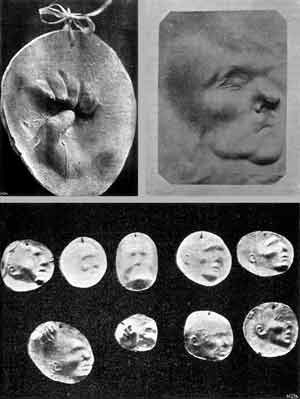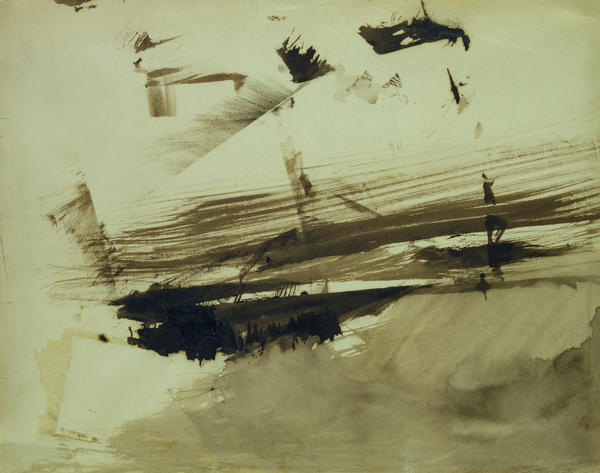Spirit-Generated Art 1871
 It seemed that Miss Houghton was inspired by the spirit drawings of
a Miss Wilkinson--it was then that she sought the artistic guidance of
a dead artistic sister though without success, and then from a dead
brother. It was the brother who brought her into contact with dead
Henry Lenny ("a deaf and dumb artist") who then guided her hands at
first with the planchette, then with a pencil, and finally to
watercolors.
It seemed that Miss Houghton was inspired by the spirit drawings of
a Miss Wilkinson--it was then that she sought the artistic guidance of
a dead artistic sister though without success, and then from a dead
brother. It was the brother who brought her into contact with dead
Henry Lenny ("a deaf and dumb artist") who then guided her hands at
first with the planchette, then with a pencil, and finally to
watercolors.After ten years of her own spirit drawings, Miss Houghton produced for herself a four-month show at the New British Gallery on Old Bond Street, exhibiting 155 of her works, all exhibited in rented frames for the occasion. Her reviews seem to have been very-light and mixed at best, and for all of her effort and trouble, she sold only one painting, She did however produce a catalog of the exhibition, which was a great aid to the viewer as the interpretations of the meanings of the forms and colors that Miss Houghton used were written on the backs of the artworks, which were hidden from view by the frames--many of the paintings' meanings were annotated in the catalog.
Miss Stoughton was hardly alone in this field of representing what seems to have been a very actice after-life of the dearly departed, though it seems that not as many participated in her own brand of automatic representation than other methods of spirit communication. She did appear at the beginning of what would become a significant culture of spiritualism, with spiritual manifestation, telepathic communication from one person to another and then to the dead, thought transference and magnetisation. The evidence of spiritual contact was produced on high levels, not the least of which were seances in which the dead appeared as floating ghosts filled with quiet or phantasmal groans and noises, sometimes luminous, sometimes leaving the medium's body as colored smoke, sometimes appearing as an electric spark, or an imprint on a photographic plate, or an aural shadow produced in iron filings, or an impression made in clay or other accepting materials2. They offered possibilities for hope and belief that are no less vigorous than our own today, save for their technological limitations. (An interesting article, "Proof Positive, the Photomatic Body in fin-de-siecle Science, by Alessandro Violi, can be seen here.)
There is a very interesting article on Houghton and the exhibition by Rachel Oberter called "Esoteric Art Confronting the Public Eye: the Abstract Spirit Drawings of Georgiana Houghton" which was published in Victorian Studies 48.2 (2005) 221-232. About the pre-Abstract abstract and proto-impressionist work, Oberter says:
"Given the lack of abstraction within
Victorian visual culture, watercolors such as those painted by the
artist Georgiana Houghton in the 1860s and 1870s seem shockingly out of
place. In her work The Eye of God from 1862, we see a tangle
of transparent straight, wavy, and spiraling lines flowing out of the
left corner of the paper and up from the bottom edge of the page as
white filaments float across the surface. No recognizable forms appear;
all that is visible are lines and colors—yellow, sepia, and blue. There
is an organic quality to the undulations, a sense of microscopic
detail, and a feeling of being in a deep-sea world or otherwise
mysterious place. The vagueness of the imagery contrasts with the
specificity of the title, which evokes a dense underlying symbolism.
Houghton attributed meaning to particular shapes, colors, and
directions in her paintings. While her works were abstract, they
remained representational."
"The most important tools for decoding
these works are the explanations that Houghton wrote on the backs of
the drawings [above] . These elaborate descriptions provide a key to
the symbolism in the drawing, clarify the message of each work, and
name the spirit who acted as Houghton's guide in the creative process.
Houghton believed that these explanations were written by the spirits
through her hands; they are automatic writings that complement her
automatic drawings. The same spirit who inspired the drawing provided
the interpretation on the back—the explanations, one could say, came
directly from the source."
The catalog does give Biblical references for every one of the
works, giving at least a location in the Bible for every artwork.
There are occasional (though sparse) longer descriptions of the work,
though the great majority give Biblical citations for what each of the
paintings represents.Also of interest is Ms. Oberter's description of the gallery event:
"...in
1871 she exhibited her works in a more formal venue: she organized an
exhibition at the New British Gallery in Old Bond Street in London. The
exhibition, entitled "Spirit Drawings in Water Colours," lasted for
four months and consisted of 155 of Houghton's watercolors. She rented
frames for the occasion and hung the watercolors against the walls of
the gallery. This arrangement meant that the backs with the
explanations would not have been visible. Yet it was still critical for
Houghton that she convey this hidden information to her viewers. In her
autobiography Houghton recalled: "The chief object aimed at in this
Exhibition, was not so much to display the wondrous powers of the
unseen intelligences, as to manifest unflinchingly to the world that
true Spiritualism is inextricably bound up with the religion of the
Sacred Scriptures" (Houghton, Evenings 2: 53). It was not
enough for Houghton that the drawings serve as proof of communication
between spirits and humans; it was also important that they convey the
relationship between Spiritualism and Christian theology, particularly
the insights that the spirits give about God and the Trinity."
The artwork of Miss Houghton is an interesting blip in the history of Victorian art, and I'm not exactly sure what to say about it. It certainly occurs during the first wave of Impressionism, and is wholly different from that new art form as well as the high Victorian fashion of the time; it also is entirely non-representational, an abstract art that precedes that revolutionary phase by about forty years. Its a little puzzling to me, especially since Miss Houghton seems to have escaped virtually any sort of lasting review or critique. But again Mrs. Stoughton is not alone in the non-representational art field apart from the automatic spirit manifestations--for example, in addition to an enormous literary output, Victor Hugo produced some 4,000 pieces of art, some of which are exceptional examples (to my mind) of non-representational art that came in a period decades before the Kandinsky and the rest. Here is Hugo's "Evocation of an Island":

He was certainly outside the mainstream of Victorian art, and even well outside that of Impressionism.
There was also Hilma of Klint (b. 1862), a woman who like Stoughton also represented the spirit world through her art, and who began painting in non-representational and abstract ways beginning in 1897/8, an example of which is below:
Miss Houghton went on to improve her representation of the spirit world through photography, a very wide selection of her work being available at the Keith De Lellis Gallery, here.

In the realm of extra-sensical belief, I'm not so sure that these brands of spiritualism would be too much different from any other belief in things that cannot be seen, or heard, or felt in any detectable way, a prayer by any other name.
Notes:
1. Our catalog was the property of William Crookes (with his bookplate, and with a signed inscription to him from "Miss Houghton") who was an eminent British chemist and physicist and a pioneer in the field of vacuum technology (and remembered now mostly for the Crookes Tubes and his superior approach to experimentation). He was interested in spiritualism from about the year 1869, pursuing it until his death in 1919. He was hardly alone in his interests among highly-paced British intellectual elite: Alfred Russell Wallace, Lord Rayleigh, Oliver Lodge and William James were all extremely interested in the spiritualism phenomenon. Curious.
2.
| Imprints of ghost hands and faces produced by Eusapia Palladino, from Bozzano, Ipotesi spiritica, 1903, in C. Lombroso Ricerche..., 1909 |
No comments:
Post a Comment